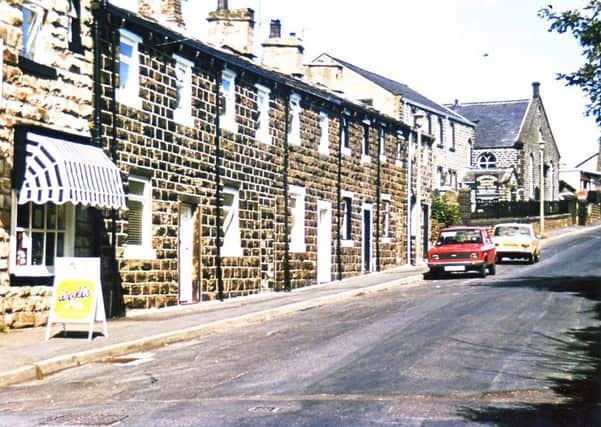How a row led to the founding of a new chapel


Hill Lane Baptist Church was founded in 1840 in the handloom weaving village of Lane Bottom, Briercliffe. The name of the church derives from the old name, Hill Lane, for what is now Halifax Road.
This comes from a property on the lane, a farm and its out-buildings, which were known as Hill Farm. The farmhouse, rebuilt in 1822 but dating from the 17th Century, is on one side of the present Halifax Road and the barn and farm buildings on the other.
Advertisement
Hide AdAdvertisement
Hide AdToday, there are three dwellings in the former farm buildings. One is the farmhouse, now known as “The Hill” and, adjoining it, is a small cottage, formerly two agricultural labourers’ cottages. The barn has been converted into large separate dwelling.


In the past, The Hill was a centre of early Nonconformist activity in that the Society of Friends (the Quakers) met there. In the garden, about five early members of that sect find their last resting place.
So the area has a long Nonconformist history. However, Hill Lane Baptist Church can trace its own history, if not to the 17th Century, when the Quakers were first active, but to the 18th Century and Haggate Baptist Church, which is in the village “next door” to Lane Bottom.
The church at Hill Lane is the result of a dispute among the members of Haggate Baptist Church which took place in 1838. The story of the dispute is quite complicated but it concerns the business activities of one of those who worshipped at Haggate. In an account of the dispute, James Hudson, a shoe maker of Marsden (Nelson) is referred to as “one of our Brethren” and it seems he had been in partnership with Robert Watson, of Colne, in the cotton manufacturing business.
Advertisement
Hide AdAdvertisement
Hide AdWithout going into all the detail, it seems James Hudson sought the advice of the church of which he was a member. This might seem odd to us but it was common, at this time, for places of worship, especially Nonconformist churches, to take on this role. Many early Nonconformists were Radicals who had little truck with the law and, in this case, it is likely lawyers would not have been able to help.
Hudson and Watson’s cotton business had not been a success but, according to the law, both partners were liable for the debts of the firm. Hudson argued that, in the original contract between the two, it was agreed he would not be responsible for any financial losses if they were to be sustained. The problem was that the contract was not written, it was merely verbal.
It is clear Haggate tried to give advice but the church came to the conclusion the “matter should be dropt (sic) where it was”, consigning, as it is put in a document held by Haggate, “to Him who is perfectly acquainted with all secrets, the great judge of all, who will certainly be right”.
Not everyone at Haggate agreed with this decision and those who could not comply with it separated from the church, founding their own place of worship in Lane Bottom in 1840. The building was erected on land donated by James Smith of Hill. He mentions the chapel in his Will of May 17th, 1852 “...as for and concerning All that Erection or Building situate near Haggate, by me, several years ago, built for and now used as a Chapel of the Congregation of Dissenters called Baptists, and the Minister’s house erected at the end thereof and the yard, conveniences and appurtenances thereto belonging ...”.
Advertisement
Hide AdAdvertisement
Hide AdThe Will adds that monies were still owed to him by the church but that, on payment of the outstanding debt, plus interest, the chapel was to be surrendered to a “Committee of the Congregation” and used for ever as a place of worship.
The first of the photogs which accompanies this article shows the 1840 building to the left and the present chapel of 1872 to the right. The chapel of 1840 is divided into two parts, the chapel to the left and the property referred to, by James Smith, as “the Minister’s house”, to the right.
There is, though, something of a problem with this in that, when Hill Lane broke away, until that is 1853, it remained, as was Haggate, a Scotch Baptist place of worship. At this time the Scotch Baptists did not appoint ministers. Haggate was led by a part time Elder, as was the case at Hill Lane. There would, therefore, have been no need, in 1840, for a minister’s house, unless Thomas Greenwood, who was part of the separation of 1838 and the first Elder at Hill Lane, lived there?
Unfortunately, so far as I know, no records survive of an Elder of the church living in the “Minister’s house”. Hill Lane remained attached to the Scotch Baptists only until 1853 when, a disagreement among worshippers, led to a number of members, including Thomas Greenwood, leaving the church.
Advertisement
Hide AdAdvertisement
Hide AdThose who remained behind appealed to the Rev. Richard Evans of Sion Baptist Chapel, Yorkshire Street, in Burnley, for help and he agreed to preach at Hill Lane on Sunday afternoons. Then a number of members, led by James Smith of Hill; Betty Thornton of Hill Row, Lane Bottom; Sarah Leaver of Blackhouse Lane, Briercliffe; Martha Smith of Pighole Farm, Briercliffe, and Peggy Crabtree of “Finneymorefoot”, suggested Hill Lane apply for membership if the English Particular Baptists. This was agreed by members and, in 1856 they appointed their first minister.